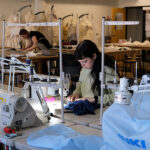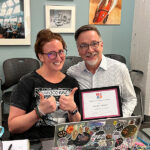
Learning for the 21st Century
What can MIAD students expect to learn in their four years?
Last year, MIAD faculty focused on this question.
Rather than compile a long list of specific skills and characteristics, we tried to devise a list of the most comprehensive and critical outcomes we want for all of our students. What will it take to be successful in the 21st Century?
To be sure, you had better be creative and dynamic, willing to learn, and you had better have a broad toolbox.
We started by creating the College Curriculum Committee, a group of faculty leaders charged with looking at the curriculum of the entire college, rather than specific majors.
We first looked at term curriculum. It’s a term we use every day in education. But what does it mean? Is it a linear, sequential set of learning experiences? Is it set of courses in a series of semesters? Is it a body of knowledge divided into units of study?
Or is it more complex?
We conducted some research and uncovered some interesting definitions. The most exciting ideas we found considered curriculum as something both flexible and planned, something that requires active participation from both the student and the teacher. All of this seemed very familiar to us, since this kind of flexibility and active-learning is essential in studio-based learning. It is something we had already been practicing. But our research confirmed our need to embrace active-learning even more. And it suggested that we keep moving toward integrated learning and to shift our thinking from being teaching-centered to learning-centered.
 At MIAD we have always prided ourselves on being student focused. And we are. The difference, I think, between being teaching-centered and learning-centered is how we look at what we do. We have exceptional teachers who take their teaching and their students seriously. The shift we are embracing is on learning. We are beginning to ask deeper questions about what learning is, how it is done, and how learning in one area is connected to learning in another. As you can imagine, this opens up exciting dialogues with our students.
At MIAD we have always prided ourselves on being student focused. And we are. The difference, I think, between being teaching-centered and learning-centered is how we look at what we do. We have exceptional teachers who take their teaching and their students seriously. The shift we are embracing is on learning. We are beginning to ask deeper questions about what learning is, how it is done, and how learning in one area is connected to learning in another. As you can imagine, this opens up exciting dialogues with our students.
Once we had a wider definition of curriculum, we moved on to college-wide outcomes. Again, we started out by conducting research. We looked at the learning outcomes of many colleges. In particular, we focused on the University of Minnesota—Twin Cities; Rose-Hulman Institute of Technology; Bowling Green State University; Indiana University at Purdue University, Indianapolis; as well as the American Association of Colleges & Universities. Each of these organizations provided clear examples of college-wide learning outcomes.
 Next, we compiled a list of all of the learning outcomes that we as faculty wanted to see our graduates possess as they leave MIAD. We made a master list, filling large sheets of paper that we taped to the wall of our conference room. As I recall we came up with a list of 38 learning outcomes!
Next, we compiled a list of all of the learning outcomes that we as faculty wanted to see our graduates possess as they leave MIAD. We made a master list, filling large sheets of paper that we taped to the wall of our conference room. As I recall we came up with a list of 38 learning outcomes!
Our next step was to group these by affinity groups, to see if any of these fit with others, or if some of these were clearly more important than others. We spent some time narrowing down the list, talking, listening, revising, reducing, improving, and tightening.
Finally, we came up with the list of eight learning outcomes.
Here are the outcomes we expect for every MIAD graduate:
- Apply critical and analytical thinking
- Demonstrate mastery of techniques and skills within one’s chosen discipline(s)
- Effectively communicate and express ideas visually, orally and in writing, using appropriate terminology
- Conduct independent inquiry and research through critical engagement through technology and information sources
- Apply creative thinking to problem-solving: identify, define, intuit, and resolve problems creatively
- Demonstrate an understanding of professional practices maintained in one’s field(s) of study
- Build an individually distinct body of work
- Create productive relationships in the community
These are challenging and interdependent outcomes that will prepare students to be successful in the 21st Century. We see these outcomes as a roadmap for preparing young artists and designers to be able to think, communicate, research, apply, create, solve, and lead — and do all of these thoughtfully, effectively, meaningfully.
–David Martin, Provost





